Potřebujeme váš souhlas k využití jednotlivých dat, aby se vám mimo jiné mohly ukazovat informace týkající se vašich zájmů. Souhlas udělíte kliknutím na tlačítko „OK“.
ASTM E2148-11b
Standard Guide for Using Documents Related to Metalworking or Metal Removal Fluid Health and Safety (Includes all amendments And changes 10/6/2016).
Automaticky přeložený název:
Standardní Příručka pro použití dokumentů vztahujících se k Zpracování kovů nebo kovů pro odstranění Fluid bezpečnost a ochranu zdraví
NORMA vydána dne 1.12.2011
Informace o normě:
Označení normy: ASTM E2148-11b
Poznámka: NEPLATNÁ
Datum vydání normy: 1.12.2011
Kód zboží: NS-44473
Počet stran: 4
Přibližná hmotnost: 12 g (0.03 liber)
Země: Americká technická norma
Kategorie: Technické normy ASTM
Kategorie - podobné normy:
Anotace textu normy ASTM E2148-11b :
Keywords:
acute toxicity testing, adenosine triphosphate, aerosol, base oils, dermatitis, endotoxins, hypersensitivity pneumonitis, metal removal fluid, metal removal fluid aerosols, metal removal fluid management, metalworking fluids, modified Ames test, mycobacteria, workplace atmospheres, Acute toxicity tests, Documents/documentation, Endotoxin units (EU), Health and safety training, Metalworking fluids/related media, Modified Ames test, Workplace air/atmospheres
Doplňující informace
| Significance and Use | ||||||||||||||||||||||||||||||||||||
|
Application of this guide will provide users with information on how to use the various documents listed in Section 2 related to health and safety of metalworking and metal removal fluids. Users of the documents listed in Section 2 may fall into several categories, such as producers of metalworking or metal removal fluids, suppliers of raw materials to those producers, users of metalworking or metal removal fluids, and other interested parties, such as non governmental organizations. While all parties may wish to be generally familiar with all the documents listed in Section 2, producers and users may each want to focus on certain documents which are directly applicable to them: Documents Applicable to Producers: E1687 Test Method for Determining Carcinogenic Potential of Virgin Base Oils in Metalworking Fluids Test Method E1687 covers a microbiological test procedure based upon the Salmonella mutagenesis assay of Ames et. al (see also Maron et al ). It can be used as a screening technique to detect the presence of potential dermal carcinogens in virgin base oils used in the formulation of metalworking oils. Persons who use this test should be well-versed in the conduct of the Ames test and conversant with the physical and chemical properties of petroleum products. Producers of metalworking fluids and metal removal fluids should assure themselves that virgin base oils used in the formulation of neat metalworking and metal removal oils and soluble and semi-synthetic metal removal fluids have an acceptable mutagenicity index or mutagenic potency index. E1302 Guide for Acute Animal Toxicity Testing of Water-Miscible Metal Removal Fluids Guide E1302 defines acute animal toxicity tests and sets forth references for procedures to assess the acute toxicity of water-miscible metal removal fluids as manufactured. Application of Guide E1302 will provide information on the acute toxicity of water-miscible metal removal fluids and will assist the user in evaluating the potential health hazards of the fluid and developing appropriate work practices. Documents Applicable to Users: E1497 Practice for Selection and Safe Use of Water-Miscible and Straight Oil Metal Removal Fluids Practice E1497 sets forth guidelines for the safe use of metal removal fluids, additives and biocides. This includes product selection, storage, dispensing, and maintenance. Water-miscible metal removal fluids are typically used at high dilution and dilution rates vary widely. Additionally, there is potential for exposure to undiluted metal removal fluid as manufactured, as well as metal removal fluid additives and biocides. Straight oils generally consist of a severely solvent-refined or hydro-treated petroleum oil, a synthetic oil, or other oils of animal or vegetable origin. Straight oils are not intended to be diluted with water prior to use. Additives are often included in straight oil formulations. E1972 Practice for Minimizing Effects of Aerosols in the Wet Metal Removal Environment Practice E1972 sets forth guidelines for minimizing effects of aerosols in the wet metal removal environment. Practice E1972 incorporates all practical means and mechanisms to minimize aerosol generation and to control effects of aerosols in the wet metal removal environment. D7049 Test Method for Metal Removal Fluid Aerosol in Workplace Atmospheres Test Method D7049 covers a procedure for the determination of both total collected particulate matter and extractable mass metal removal fluid aerosol concentrations in a range from 0.05 mg/m3 to 5 mg/m3 in workplace atmospheres. Test Method D7049 describes a standardized means of collecting worker exposure information that can be compared to existing exposure databases, using a test method that is also more specific to metal removal fluids. E2144 Practice for Personal Sampling and Analysis of Endotoxin in Metalworking Fluid Aerosols in Workplace Atmospheres Practice E2144 covers quantitative methods for the personal sampling and determination of bacterial endotoxin concentrations in polydisperse metal removal fluid aerosols in workplace atmospheres. Users should have fundamental knowledge of microbiological techniques and endotoxin testing. Endotoxins in metal removal fluid aerosols present potential respiratory hazards to workers who inhale them. Users of Practice E2144 may obtain personal exposure data of endotoxin in metal removal fluid aerosols, either on a short-term or full-shift basis in workplace atmospheres. Practice E2144 gives an estimate of the endotoxin concentration of the sampled atmosphere. Practice E2144 seeks to minimize interlaboratory variation, but does not ensure uniformity of results. 4.5.4.6 It is anticipated that Practice E2144 will facilitate interlaboratory comparisons of airborne endotoxin data from metalworking fluid atmospheres, particularly metal removal fluid atmospheres, by providing a basis for endotoxin sampling, extraction, and analytical methods. E2169 Practice for Selecting Antimicrobial Pesticides for Use in Water-Miscible Metalworking Fluids Practice E2169 provides recommendations for selecting antimicrobial pesticides (microbiocides) for use in water-miscible metalworking fluids (MWF). It presents information regarding regulatory requirements, as well as technical factors including target microbes, efficacy and chemical compatibility. Practice E2169 is not an encyclopedic compilation of all the concepts and terminology uses by chemists, microbiologits, toxicologists, formulators, plant engineers and regulatory affairs specialists involved in antimicrobial pesticide selection and application. Instead, it provides a general understanding of the selection process and its supporting considerations. E2657 Test Method for Determination of Endotoxin Concentration in Water Miscible Metalworking Fluids Test Method E2657 covers quantitative methods for the sampling and determination of Gram-negative bacterial endotoxin concentrations in water miscible metalworking fluids (MWF). Users of Test Method E2657 should be familiar with the handling of MWF. Test Method E2657 gives an estimate of the endotoxin concentration of the sampled MWF. (1) Used on site, Test Method E2657 gives an indication of changes in Gram-negative bacterial contamination in the MWF. (2) Test Method E2657 does not replace Practice E2144. Test Method E2657 seeks to minimize inter-laboratory variation but does not ensure uniformity of results. Test Method E2657 is intended to relate endotoxin concentration in MWF to health effects of inhaled endotoxin. E2563 Test Method for Enumeration of Non-Tuberculosis Mycobacteria in Aqueous Metalworking Fluids by Plate Count Method Test Method E2563 covers the detection and enumeration of viable and culturable rapidly growing Mycobacteria (RGM), or non-tuberculosis Mycobacteria (NTM) in aqueous metalworking fluids (MWF) in the presence of high non-mycobacterial background population using standard microbiological culture methods. NTM such as Mycobacterium immunogenum have been implicated as causative agents of the respiratory disease, extrinsic allergic aveolitis (also known as hypersensitivity pneumonitis; HP). The measurement of viable and culturable mycobacterial densities combined with the total mycobacterial counts (including viable culturable (VC), viable-non culturable (VNC) and non viable (NV) counts) is usually the first step in establishing any possible relationship between Mycobacteria and occupational health concerns (for example, HP). Test Method E2563 can be employed in survey studies to characterize the viable-culturable mycobacterial population densities of metal working fluid field samples. Test Method E2563 is also applicable for establishing the mycobacterial resistance of metalworking fluid formulations by determining mycobacterium survival by means of plate count technique. Test Method E2563 can be used to evaluate the relative efficacy of microbicides against Mycobacteria in metalworking fluids. E2564 Test Method for Enumeration of Mycobacteria in Metalworking fluids by Direct Microscopic Counting (DMC) Method Test Method E2564 describes a direct microscopic counting method (DMC) for the enumeration of the acid fast stained mycobacteria population in metalworking fluids. It can be used to detect levels of total mycobacteria population, including culturable as well as non-culturable (possibly dead or moribund ) bacterial cells. This test method is recommended for all water-based metalworking fluids. As noted in 4.5.7.1, non-tuberculosis mycobacteria are common members of the indigenous MWF bacterial population that have been implicated as agents of HP. Test Method E2564 provides a quantitative assessment of the total numbers of acid-fast bacilli; using acidfast staining to selectively identify mycobacteria from other bacteria, followed by enumeration or direct microscopic counting of a known volume over a known area. Although other microbesparticularly the Actinomycetesalso stain acid fast, they are differentiated from the mycobacteria because of their morphology and size. Non-mycobacteria, acidfast microbes are 50-100 times larger than mycobacteria. Test Method E2564 provides quantitative information on the total (culturable and non-culturable viable, and non-viable) mycobacteria populations. The results are expressed quantitatively as mycobacteria per mL of metalworking fluid sample. The DMC method using the acid-fast staining technique is a semi-quantitative method with a relatively fast turnaround time. The DMC method can also be employed in field survey studies to characterize the changes in total mycobacteria densities of metalworking fluid systems over a long period of time. The sensitivity detection limit of the DMC method depends on the MF and the sample volume (direct or centrifuged, etc.) examined. E2694 Test Method for Measurement of Adenosine Triphosphate in Water-Miscible Metalworking Fluids Test Method E2694 provides a protocol for capturing, extracting and quantifying the adenosine triphosphate (ATP) content associated with microorganisms found in MWF. Test Method E2694 measures the concentration of ATP present in the sample. ATP is a constituent of all living cells, including bacteria and fungi. Consequently, the presence of ATP is an indicator of total microbial contamination in metalworking fluids. ATP is not associated with matter of non-biological origin. The ATP test provides rapid test results that reflect the total bioburden in the sample. It thereby reduces the delay between test initiation and data capture, from the 36 h to 48 h (or longer) required for culturable colonies to become visible, to approximately five minutes. Although ATP data generally covary with culture data in MWF , different factors affect ATP concentration than those that affect culturability. Because ATP is present in all living organisms, Test Method E2694 can be used as a first-screen to determine whether additional microbiological testing is needed. Although there is no consensus on the exact relationship between bulk MWF bioburdens and bioaerosol concentrations, it is generally recognized that higher bulk fluid bioburdens imply higher bioaerosol concentrations. E2693 Practice for Prevention of Dermatitis in the Wet Metal Removal Fluid Environment 4.5.10.1 Practice E2693 sets forth guidelines for reducing dermatitis caused by exposure to the wet metal removal environment. The scope of this practice does not include exposure to chemicals that enter the body through intact skin (cutaneous route), which has the potential to cause other toxic effects. Practice E2693 incorporates means and mechanisms to reduce dermal exposure to the wet metal removal environment and to control factors in the wet metal removal environment that have the potential to cause dermatitis. Practice E2693 focuses on employee exposure to the skin via contact and exposure to metal removal fluid (MRF). Documents Applicable to All: Management of the Metal Removal Fluid Environment: A Guide to the Safe and Efficient Use of Metal Removal Fluids This guide collects best practices in the management of metal removal fluid systems and provides an educational tool to assist users in taking control of the MRF systems in their workplaces. For many industrial organizations, focusing on the systematic management of MRF systems has proven effective in controlling exposures in the wet metal removal/machining environment. The recommendations are distilled from the experiences of Organization Resources Counselors member companies and represent best practice. Criteria for a Recommended Standard: Occupational Exposure to Metalworking Fluids This criteria document reviews available information about the adverse health effects associated with occupational exposure to metalworking fluids and metalworking fluid aerosols. Criteria documents provide the scientific basis for new occupational safety and health standards and contain a critical review of the scientific and technical information available on the prevalence of hazards, the existence of safety and health risks, and the adequacy of control methods. Metalworking Fluids: Safety and Health Best Practices Manual This document reviews best practices as documented by the Occupational Safety and Health Administration, including engineering and work practice controls, establishing a metalworking fluid management program, instituting an exposure monitoring program, medical monitoring of exposed employees and training. This manual is not a standard or regulation and creates no new legal obligations. It is advisory in nature, informational in content, and is intended to assist employers in providing a safe and healthful workplace for workers exposed to metalworking fluids through effective prevention programs adapted to the needs and resources of each place of employment. |
||||||||||||||||||||||||||||||||||||
| 1. Scope | ||||||||||||||||||||||||||||||||||||
|
1.1 This guide covers information on how to use documents related to health and safety of metalworking and metal removal fluids. As such, this guide will provide the user with sufficient background information to effectively use the documents listed in Section 2. Documents referenced in this guide are grouped as applicable to producers, to users or to all. 1.2 This standard does not purport to address all of the safety concerns, if any, associated with its use. It is the responsibility of the user of this standard to establish appropriate safety and health practices and determine the applicability of regulatory requirements prior to use. |
||||||||||||||||||||||||||||||||||||
| 2. Referenced Documents | ||||||||||||||||||||||||||||||||||||
|
Podobné normy:
Historická
1.12.2009
Historická
1.8.2010
Historická
1.7.2009
Historická
1.8.2014
Historická
1.3.2010
Historická
15.2.2009
Odebírejte informace o nově vydaných normách ZDARMA:
Chcete pravidelně odebírat informace o nově vycházejících normách z celého světa a to zcela zdarma?
Přihlašte se k odběru. Vše je velice jednoduché a absolutně ZDARMA.
Na výběr máte vydavatele z celého světa.


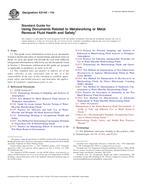
 ASTM E1499-97(2009)..
ASTM E1499-97(2009)..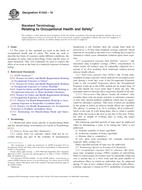 ASTM E1542-10
ASTM E1542-10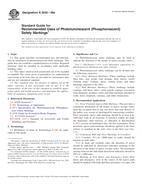 ASTM E2030-09a
ASTM E2030-09a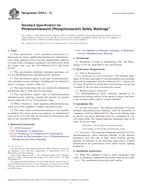 ASTM E2072-14
ASTM E2072-14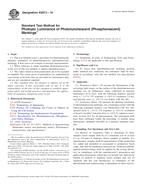 ASTM E2073-10
ASTM E2073-10 ASTM E2565-09
ASTM E2565-09
 Cookies
Cookies
